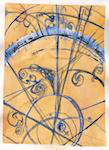Speaker
Description
Electron-positron pairs produced in ultra-relativistic heavy-ion collisions at the LHC carry important information about the system space-time evolution unperturbed by strong final-state interactions. The dielectron continuum is very rich in physics sources: on top of Dalitz and resonance decays of pseudo-scalar and vector mesons, thermal black-body radiation contains the information about the temperature of the hot and dense system created in heavy-ion collisions. Correlated electron pairs from semi-leptonic charm and beauty decays provide information about the heavy-quark energy loss. Such pairs dominate in the intermediate mass region (1.1 < $m_{\rm{ee}}$ < 2.7 GeV/$c^{2}$) and can be used for complementary studies of heavy-flavour production.
Recently, proton--proton collisions with high charged-particle multiplicities have been found to exhibit interesting phenomena, such as the longitudinal structure in the two-dimensional angular correlation and the enhanced strangeness production. The production of heavy-flavour hadrons that increases with charged-particle multiplicity could be explained by a substantial contribution from multiple parton interactions. Measurements of low-mass dielectrons could provide additional information regarding the underlying physics processes in high-multiplicity pp collisions.
In this talk, we present the latest results of the dielectron analysis with ALICE in pp collisions at $\sqrt{s}$ = 13 TeV. A particular focus of the discussion is put on the modification of dielectron spectrum in pp collisions collected with a trigger on high charged-particle multiplicities with respect to the inelastic events. The relative increase of dielectron production in high-multiplicity events is compared to the expectations from already measured multiplicity-dependent production of light and heavy hadrons. The production of direct photons in inelastic and high-multiplicity collisions is also discussed.
